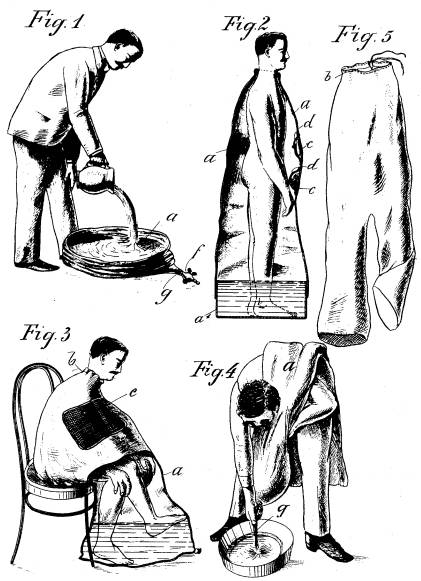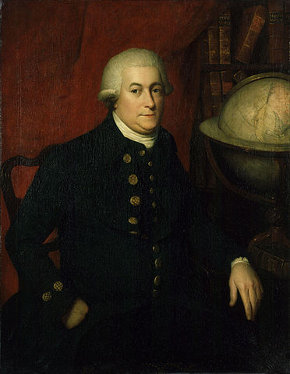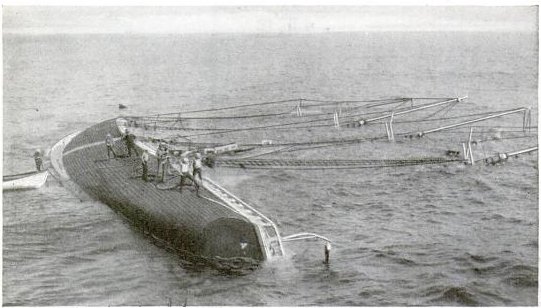1. Find an expression for the number 1 that uses each of the digits 0-9 once.
2. Do the same for the number 100.
3. Write 31 using only the digit 3 five times.
4. Express 11 with three 2s.
5. Express 10 with two 2s.
6. Express 1 with three 8s.
7. Express 5 with two 2s.
Author: Greg Ross
Inside Job

Viennese inventor Adolf Herz patented this “portable bath or sack for washing or bathing purposes” in 1904. Fill it with “bathing agent or fluid,” step in, and close the upper end around your neck, and draw your soap, sponge, and towel from pockets in the interior.
Bathing or washing can be effected in the sack with every convenience. Splashing of water and wetting of the floor is thus entirely prevented. Also by means of the sack the evaporation of the water on the body otherwise taking place in bathing and washing is prevented, whereby the catching of colds is avoided. The bathing and washing can therefore be done in cool places. Also radiation of the heat of the body is considerably reduced, whereby a very agreeable sensation is produced when using the sack.
Afterward you can drain it through a runoff pipe. “After the sack has been emptied it can be folded together, so as to occupy a very small space, and then, if desired, tied or fastened together and kept in a bag, satchel, knapsack, or the like.”
The Bat Bomb

Pennsylvania dentist Lytle S. Adams had a bright idea in 1942: Since Japanese cities were largely built of paper, bamboo, and other flammable materials, they could be disrupted effectively with fire. And a novel way to spread fire in public buildings would be to release bats bearing incendiary devices. Rigged bats dropped over an industrial city would roost in the buildings as living time bombs, and the resulting fires would spread chaos over a wide area.
Surprisingly, the government liked the idea, and it set about designing a bomblike canister in which a thousand bats could be dropped from an altitude of 5,000 feet. At 1,000 feet the container would open, releasing the bats over a wide area. Ten bombers carrying 100 canisters each could unleash a million intelligent bombs over the industrial cities of Osaka Bay.
Preliminary tests were encouraging, even setting a New Mexico air base accidentally ablaze, but the project evolved too slowly and was eventually eclipsed by the atom bomb. In a way that’s a shame: “Think of thousands of fires breaking out simultaneously over a circle of 40 miles in diameter for every bomb dropped,” Adams had said. “Japan could have been devastated, yet with small loss of life.”
Animal Behavior
A logic exercise by Lewis Carroll. What conclusion can be drawn from these premises?
- Animals are always mortally offended if I fail to notice them.
- The only animals that belong to me are in that field.
- No animal can guess a conundrum unless it has been properly trained in a Board-School.
- None of the animals in that field are badgers.
- When an animal is mortally offended, it rushes about wildly and howls.
- I never notice any animal unless it belongs to me.
- No animal that has been properly trained in a Board-School ever rushes about wildly and howls.
Disappearing Act
Some amoebae, to be sure, do die. Sometimes an amoeba cannot get sufficient food or oxygen or moisture to sustain its life, and that kills it. But some amoebae do not get an opportunity to die … let us consider a well-fed, healthy amoeba alone in a drop of well-oxygenated pond water. I shall call it ‘Alvin.’ Alvin, let us suppose, lives happily through Tuesday and then, precisely at the stroke of midnight, Alvin divides, producing two offspring whom I shall call ‘Amos’ and ‘Ambrose.’ On Wednesday, we find two amoebae — Amos and Ambrose — swimming happily about in our drop of pond water. But what has become of Alvin? One thing is quite clear: Alvin is not an inhabitant of our drop of pond water on Wednesday. … His life, therefore, must have come to an end. But it is equally clear that Alvin did not die.
— Jay F. Rosenberg, Thinking Clearly About Death, 1983
Lost History

Each year on the last Saturday in April, the citizens of Ocean Shores, Washington, celebrate “Undiscovery Day” to commemorate the night in 1792 when British explorer George Vancouver sailed right past their harbor without discovering it.
At midnight they gather on the shore and shout “Hey George — over here!”
Query
Unquote
“When lost in a forest go always down hill. When lost in a philosophy or doctrine go upward.” — Ambrose Bierce
Addition and Subtraction

In Mathematical Applications of Political Science, University of Minnesota political scientist William Riker describes a worrisome voting paradox that unfolded in the U.S. House of Representatives in 1956. At issue was a bill calling for federal aid for school construction; an amendment was proposed that would have offered this aid only to states whose schools were integrated. The House was divided into three interest groups:
- Republicans opposed federal aid in general but supported integration. They would have preferred no bill at all but favored the amended bill to the original.
- Northern Democrats wanted the amended bill but would accept the original bill rather than have no bill at all.
- Southern Democrats, whose schools were segregated, favored the original bill but would prefer to have no bill rather than accept the amendment.

Clearly the original bill would have passed, as the Democrats as a group preferred it to having no bill at all. But, following procedure, the House voted first on whether to accept the amendment, and here the Republicans and the northern Democrats combined to support it, since both preferred the amended bill to the original bill. The second vote addressed whether to accept the now-amended bill, and now the Republicans and the southern Democrats united to kill it, since both preferred no bill to the amended bill.
So the original bill was popular, and the proposed amendment was popular, but combining them led to the bill’s defeat. “As if it were not enough that the choice may depend on the voting order, this fact can be used to twist the outcome of the legislative process,” Riker writes. “It may be possible to create a voting paradox such that no action is taken by the legislature even though a proposed bill would have passed prior to the creation of the paradox. A legislator could introduce an amendment to create such a paradox, and if the voting order were just right, the amended proposal would then be defeated.”
Back Again

In 1929 the schooner A. Ernest Mills sank after a collision off the coast of North Carolina.
Four days later it bobbed to the surface again. Its cargo of salt had dissolved.
